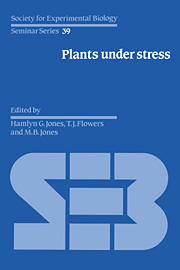Book contents
- Frontmatter
- Contents
- Contributors
- Preface
- 1 Introduction: some terminology and common mechanisms
- 2 The impact of environmental stresses on ecosystems
- 3 Whole-plant responses to stress in natural and agricultural systems
- 4 Photosynthesis and gas exchange
- 5 Regulation of growth and development of plants growing with a restricted supply of water
- 6 Stresses, membranes and cell walls
- 7 Desiccation injury, anhydrobiosis and survival
- 8 Molecular biology: application to studies of stress tolerance
- 9 Environmental control of gene expression and stress proteins in plants
- 10 Plant tissue and protoplast culture: applications to stress physiology and biochemistry
- 11 Breeding methods for drought resistance
- 12 Selection for physiological characters – examples from breeding for salt tolerance
- 13 Prospects for improving crop production in stressful environments
- Index
1 - Introduction: some terminology and common mechanisms
Published online by Cambridge University Press: 16 March 2010
- Frontmatter
- Contents
- Contributors
- Preface
- 1 Introduction: some terminology and common mechanisms
- 2 The impact of environmental stresses on ecosystems
- 3 Whole-plant responses to stress in natural and agricultural systems
- 4 Photosynthesis and gas exchange
- 5 Regulation of growth and development of plants growing with a restricted supply of water
- 6 Stresses, membranes and cell walls
- 7 Desiccation injury, anhydrobiosis and survival
- 8 Molecular biology: application to studies of stress tolerance
- 9 Environmental control of gene expression and stress proteins in plants
- 10 Plant tissue and protoplast culture: applications to stress physiology and biochemistry
- 11 Breeding methods for drought resistance
- 12 Selection for physiological characters – examples from breeding for salt tolerance
- 13 Prospects for improving crop production in stressful environments
- Index
Summary
Introduction
The study of plant responses to stress has been a central feature of environmental physiologists' attempts to understand how plants function in their natural environment and in particular to explain patterns of plant distribution and their performance along environmental gradients (Osmond et al., 1987). The best of these studies have had a vertical integration from cellular to ecosystem processes (e.g. Björkman, 1981). The primary object of this volume is to bring together contributions from ecologists, physiologists, molecular biologists and plant breeders, who each have their own perspectives on stressful environments and how plants perform in them, and to consider how their understanding of plant responses may be applied by plant breeders. Unfortunately in a book of this size it is not possible to cover all types of stress. In particular, detailed treatment of plant responses to temperature extremes has been omitted as it is the subject of a recent SEB symposium volume (Long & Woodward, 1988), and the extensive potentially relevant work on, for example, pollution, pests and pathogens, and mineral nutrition has been omitted.
In recent years the extended controversy concerning the appropriate terminology to use in studies of plant responses to stressful environments (e.g. Kramer, 1980; Levitt, 1980; Harper, 1982) has often detracted attention from the identification and understanding of underlying principles. Despite this it is useful at this stage to outline the main concepts involved and attempt to provide a generally acceptable common framework for further discussions.
- Type
- Chapter
- Information
- Plants under StressBiochemistry, Physiology and Ecology and their Application to Plant Improvement, pp. 1 - 10Publisher: Cambridge University PressPrint publication year: 1989
- 21
- Cited by

